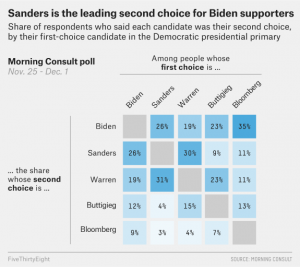In her Cook Political Report article, “The Majority Is In Play” about Democratic prospects for winning back Senate control, Jennifer E. Duffy writes that “Democrats appear to have expanded the playing field enough to put Republicans’ majority at risk…Recent polls have shown Trump’s job approval numbers have ticked up a bit during the House’s consideration of the Articles of Impeachment. While the gains are small and not especially meaningful, Democrats weren’t expecting such gains, but the reverse…It appears that there will be at least five GOP-held seats in play, with a chance that Democrats could add one or two more. This puts Democrats in a position to win the majority, even if they lose Alabama and/or Michigan. This is not to suggest that Democrats will win the majority, only that their prospects are considerably better today than they were five months ago.”
In his year-ender column at Sabato’s Crystal Ball, Kyke Kondik assesses Democratic prospects to win back control of the Senate: “Since our initial assessment, we did move North Carolina to the ranks of the Toss-ups, although Democratic odds are likely better in their other two Toss-up targets, Arizona and Colorado. Sen. Thom Tillis (R-NC) has gotten some good news over the past several weeks: his one-time primary challenger, businessman Garland Tucker (R), left the race, and Rep. Mark Walker (R, NC-6) opted to retire in the face of redistricting instead of enter the primary, which means Tillis can turn his attention to the general election now. The true vulnerability of Republicans in the Leans Republican column, namely Collins and Joni Ernst (R-IA), remains something of a question mark, although each very well could be pushed hard next year. Collins, in particular, seems to face a no-win situation on impeachment: A vote to acquit will further nationalize her and imperil her longstanding crossover appeal (after her vote to confirm Brett Kavanaugh for a Supreme Court seat already nationalized her to a great degree last year), while a vote to convict will soften her with Republicans. Without defeating at least one of Collins or Ernst, the Democratic path to a majority is likely blocked…Our best guess at this point would be for something like a net Democratic gain of a seat, short of the three net seats Democrats need to forge a 50-50 tie. So we still favor the Republicans overall in the battle for the Senate, but the Democrats have enough targets to win control.”
At Vox, Matthew Yglesias has some disturbing notes on the massive power imbalance presented by the U.S. Senate: “The growing polarization of the white vote along the lines of population density and educational attainment has also supercharged the once-modest partisan skew of the Senate, making even the most popular changes to health care or minimum-wage policy an extremely heavy lift…Today, the smallest state is Wyoming, and the state of Washington has about 12.6 times as many people. Of course, Washington isn’t the largest state. Indeed, it’s not even particularly close — 12 states are bigger. Illinois has 22 times Wyoming’s population. Texas is nearly 50 times as big (and growing fast). And California is a stunning 68 times as large…If California had been carved up into Massachusetts-sized states, it could be easily 15 or 16 separate entities — each with about four times the population of Wyoming — rather than the current mismatch…though the current GOP majority in the Senate is of recent vintage, it’s also built on a remarkably thin electoral base. In 2014, Republican candidates won 52 percent of the vote and gained nine Senate seats. Two years later, Democrats won 54 percent of the vote and gained only two seats.” Yglesias goes on to note formidable problems with proposals to admit Washington, D.C. and Puerto Rico as states to reduce the Senate’s bulit-in bias, although they are probably the most doable reforms. Correcting such structural injustices, however, will require a Democratic landslide or two.
Eleanor Clift’s “Here Are 10 House Democrats Who Really Put It on the Line Voting to Impeach Trump” at The Daily Beast should be of extra interest to Democrats concerned about helping to protect the party’s vulnerable House members. As Clift writes, “Freshmen Democrats in districts previously held by Republicans face the greatest risk. This group, dubbed “frontline” Democrats, many of them women, voted to hold President Trump accountable on both articles of impeachment knowing full well the possible consequences…“The political implications of impeachment for Democrats in Trump districts was unclear, but they voted yes because they knew it was the right thing to do, and have to live with themselves for the rest of their lives,” says David de la Fuente with Third Way, a moderate Democratic group that at The Daily Beast’s request identified 10 freshmen Democrats with the most to lose in casting their vote for impeachment.” Six of the ten endangered Dem House members are women.
Clift adds, “Three of these freshmen lawmakers—Elissa Slotkin of Michigan, and Abigail Spanberger and Elaine Luria of Virginia—were among a group of seven newly elected Democrats with national security credentials who stepped forward in September to support impeachment after it became public that Trump had withheld military aid from Ukraine in exchange for dirt on a political rival, former Vice President Joe Biden.” Clift provides capsule descriptions of the political situation for each of the 10 vulnerable Democrats, including Elissa Slotkin (MI-8); Abigail Spanberger (VA-7); Elaine Luria (VA-2); Lucy McBath (GA-6); Haley Stevens (MI-11); Xochitl Torres Small (NM-2); Anthony Brindisi (NY-22); Kendra Horn (OK-5); Joe Cunningham (SC-1); and Ben McAdams (UT-4). Here’s ActBlue’s gateway link to helping protect these and other Democratic House members (Click on the state and scroll to the member).
In their FiveThirtyEight post, “Who Won The December Democratic Debate?,” Aaron Bycoffe, Sarah Frostenson and Julia Wolfe write that “we once again partnered with Ipsos to track how the debate, hosted by “PBS NewsHour” and Politico, affected likely primary voters’ feelings about the candidates on the stage… Biden received high marks, as he hasn’t fared nearly as well in some of our otherpost-debate surveys. Warren and Sanders were tied for a close second place in their debate grade, but, like with Biden, their pre-debate favorability ratings meant we figured voters would rate them positively — Warren was even slightly worse than expected. Andrew Yang and Amy Klobuchar, on the other hand, did better than expected given their pre-debate favorability ratings, earning the third-highest marks. Being the focus of several of his rivals’ attacks seems to have hurt Pete Buttigeg; he got low marks relative to how well-liked he was going into the debate. Tom Steyer also failed to make a positive impression.”
Bycoffe, Frostenson and Wolfe add that “Yang and Klobuchar saw the largest jumps in net favorability (favorable rating minus unfavorable rating) — 6.3 points and 6.1 points, respectively. Most of the other candidates made more modest gains of 2 or 3 points; Buttigieg was the only candidate whose net favorability fell — it dropped by about 2 points…We asked respondents to estimate each Democrat’s chances of defeating Trump, from 0 percent (no chance) to 100 percent (certain to win). Going into the debate, as in other general-election polls, Biden was the candidate voters thought was most likely to beat Trump, on average. He still leads on that question after the December debate, but…his average dropped by roughly half a point. Klobuchar, on the other hand, made the largest gains by this metric, with her average rating increasing by 4 points. Other candidates, like Yang and Steyer, saw more modest increases, while Buttigieg saw a small downtick.”
For those who are wondering “How’s Impeachment Play in the ‘Burbs?,” Charlie Cook has some answers at The Cook Political Report: “Last year, Senate Democrats had many more seats at risk than did the GOP. This year, the battlegrounds are overwhelmingly in red, Republican-tilting states. Again, more of the fight will be in the suburbs, where Republicans are playing defense, than in rural and small-town America, where the tide is shifting against Democrats. Whether Republicans hold their majority will be determined in suburbs of Phoenix and Tucson, where Sen. Martha McSally is defending her Arizona seat; Atlanta, with two GOP seats up in Georgia next year; Denver, with Sen. Cory Gardner of Colorado holding on for dear life; the suburbs outside of Des Moines for Sen. Joni Ernst of Iowa; Portland, Maine with Sen. Susan Collins; and in North Carolina’s Research Triangle and Charlotte for Sen. Thom Tillis. Some argue that Sen. John Cornyn faces a threat in the suburbs of Dallas, Houston, and San Antonio, though I remain skeptical that he will have quite as much difficulty as Sen. Ted Cruz had last year. Texas is trending purple, but maybe not fast enough for Democrats in 2020. Impeachment will do no favors for Democratic Sen. Doug Jones of Alabama, but his race was so difficult before, it couldn’t get much steeper than it already was.”
“After the 2018 midterm elections, Gallup asked Democrats and Republicans where they hoped their respective parties would move ideologically. The results are instructive — about the trajectories of both the impeachment debate and the Democratic contest for president…When Democrats and Democratic-leaning independents were asked if they would rather see their party become more liberal or more moderate, 54 percent said more moderate, 41 percent said more liberal. Republicans, by contrast, think their already radicalized party is still not conservative enough: Fifty-seven percent said they wanted the party to become more conservative; only 37 percent said more moderate…The results added to the mountains of evidence showing how the political polarization we talk about so much is asymmetric: Republicans have not only moved much further to the right than the Democrats have moved left, the GOP wants to keep moving toward the outer edges.” – From “Democrats understand moderation. Republicans don’t” by E. J. Dionne, Jr. in The Washington Post.





